Unlock the full potential of your online store by optimizing every aspect of your product pages.
Hey there, fellow Shopify merchants! I’m here today to share some invaluable insights on a topic that’s absolutely crucial for your online store’s success: product listing best practices. Think of your product pages as your digital storefront – they’re where potential customers make their buying decisions.
A well-optimized product listing isn’t just about showcasing what you sell; it’s about creating an experience, building trust, and ultimately, converting browsers into buyers. I’ve seen countless stores struggle because their product pages weren’t doing their job, and I want to help you avoid those pitfalls.
Let’s dive right into the first, and arguably most impactful, element: **High-Quality Product Imagery and Video**. This is non-negotiable. Your customers can’t physically touch or feel your products online, so your visuals need to be stunning.
I always recommend using multiple high-resolution images from various angles. Show the product in use, highlight its unique features, and include lifestyle shots that help customers envision themselves owning it. Don’t forget close-ups for texture and detail.
Beyond static images, consider incorporating product videos. A short, engaging video can demonstrate functionality, scale, and even the emotional connection to your product in a way that photos simply can’t. Shopify makes it easy to embed these directly.
Next up, we have **Compelling Product Descriptions**. This is where you tell your product’s story. Don’t just list features; explain the benefits. How will this product solve a problem for your customer or enhance their life?
I advise using clear, concise language, but don’t be afraid to inject your brand’s personality. Use bullet points for easy readability of key features, and then elaborate in paragraph form. Think about your target audience and speak directly to them.
Remember to include all necessary information: dimensions, materials, care instructions, and anything else a customer might need to know before purchasing. Transparency builds trust.
**Search Engine Optimization (SEO)** is another critical component. Your product listings need to be discoverable. I always start with keyword research to understand what terms my potential customers are using to find products like mine.
Integrate these keywords naturally into your product titles, descriptions, image alt text, and even your URL handles. Shopify provides fields for SEO title and meta description – use them wisely to entice clicks from search results.
Speaking of titles, your **Product Title** should be clear, descriptive, and include your primary keyword. It should immediately tell the customer what the product is. Avoid jargon unless your audience understands it.
**Managing Product Variants and Options** is essential for many businesses. If your product comes in different sizes, colors, materials, or other variations, make sure these are clearly presented and easy to select.
Shopify’s variant system is powerful. I recommend using clear labels for each option and ensuring that the corresponding image updates when a different variant is selected. This visual confirmation is very reassuring for customers.
**Strategic Pricing** is more than just putting a number on your product. Consider your perceived value, competitor pricing, and your profit margins. Sometimes, a slightly higher price can convey quality, while a lower one might suggest a bargain.
Don’t shy away from showing sale prices with the original price crossed out – this creates a sense of urgency and value. I’ve found this to be a very effective psychological trigger.
**Leveraging Customer Reviews and Social Proof** is incredibly powerful. People trust other people more than they trust brands. Integrate a review app into your Shopify store and actively encourage customers to leave feedback.
Displaying star ratings and testimonials prominently on your product pages can significantly boost conversion rates. I’ve seen stores transform their sales just by adding genuine customer reviews.
Your **Call to Action (CTA)** needs to be crystal clear. The “Add to Cart” button should stand out, be easy to find, and use compelling language. Consider its color, size, and placement.
I also recommend ensuring your product pages are **Mobile-Optimized**. A significant portion of online shopping now happens on mobile devices. Your pages must load quickly and display perfectly on smaller screens.
**Clear Shipping and Return Information** is paramount. Customers want to know exactly what to expect. I always include a dedicated section or link to my shipping policy and return policy directly on the product page or very close to the “Add to Cart” button.
This transparency reduces cart abandonment and post-purchase inquiries. It builds confidence and shows you’re a trustworthy merchant.
**Cross-selling and Upselling** opportunities should not be missed. Shopify allows you to recommend related products or higher-value alternatives. “Customers who bought this also bought…” or “Complete the look with…” are great ways to increase average order value.
**Effective Product Categorization and Tagging** helps customers navigate your store and find what they’re looking for. Use logical collections and tags that make sense to your audience. This also aids SEO.
I also pay close attention to **URL Structure**. Keep your product URLs clean, descriptive, and keyword-rich. Shopify usually does a good job with this, but you can customize them for better SEO.
Finally, **Regularly Review and Update Your Listings**. Your products, your market, and your customers’ needs evolve. I make it a habit to revisit my top-performing and underperforming product pages to see where improvements can be made.
This might involve A/B testing different descriptions, images, or CTA button colors. Small tweaks can lead to significant gains over time.
What do you think about this article? I’m always eager to hear your thoughts and experiences.
By implementing these best practices, you’re not just listing products; you’re crafting compelling sales tools that work tirelessly for your business. I truly believe that a strong foundation in product page optimization is key to unlocking your Shopify store’s full potential.






